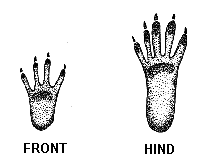
Red Squirrel
Tamiasciurus hudsonicus or Pine Squirrel, Chickaree
Description
- The red squirrel is rust-red to greyish-red above
being brightest on the sides, white or greyish-white
below and the tail is similar to the back color but
is outlined with a broad, black band edged in white.
The coat is duller in the summer and a black line separated
the back and underbelly colours. The average red squirrel
weighs 7-12 ounces.
Distribution - The red squirrel is abundant in any
kind of forest, coniferous, pine, mixed or hardwood
forests, often around buildings. They occur through
much of Canada and most of B.C.
Biology - This creature feeds heavily on pine seeds
and in the fall it cuts green cones and buries them
in damp earth ; other sustenance includes nuts, seeds,
birds' eggs, young birds and fungi. It makes a nest
of leaves in a hollow or fallen tree, hole in the ground
or tree crotch. 3-7 young are born in March or April
and there is sometimes a second litter in August or
September. The squirrel is a chatterbox with a variety
of calls to announce its home range or the presence
of intruders.
 Tracks - Tracks are common between trees and
near holes in the ground where they have dug up buried
cones. Squirrels place their feet next to each other
rather than one in front of the other. In deep snow
their tracks are characterized by two diamond shapes
next to one another. A clear imprint will reveal five
long toes with claws similar to the skeleton of a human
hand and may or may not have a heel print. The heel
is as long again as the toes and a rough oval shape.
Tracks - Tracks are common between trees and
near holes in the ground where they have dug up buried
cones. Squirrels place their feet next to each other
rather than one in front of the other. In deep snow
their tracks are characterized by two diamond shapes
next to one another. A clear imprint will reveal five
long toes with claws similar to the skeleton of a human
hand and may or may not have a heel print. The heel
is as long again as the toes and a rough oval shape.
Straddle: 8 - 12 cm (3.2 - 4.8 in)
Stride: 13 - 25 cm (5.2 - 10 in)
Track: Front - 3 cm (1.2 in) long / 3 cm (1.2 in) wide
Track: Rear - 4.5 cm (1.8 in) long / 2.5 cm (1 in) wide


 Tracks - Tracks are common between trees and
near holes in the ground where they have dug up buried
cones. Squirrels place their feet next to each other
rather than one in front of the other. In deep snow
their tracks are characterized by two diamond shapes
next to one another. A clear imprint will reveal five
long toes with claws similar to the skeleton of a human
hand and may or may not have a heel print. The heel
is as long again as the toes and a rough oval shape.
Tracks - Tracks are common between trees and
near holes in the ground where they have dug up buried
cones. Squirrels place their feet next to each other
rather than one in front of the other. In deep snow
their tracks are characterized by two diamond shapes
next to one another. A clear imprint will reveal five
long toes with claws similar to the skeleton of a human
hand and may or may not have a heel print. The heel
is as long again as the toes and a rough oval shape.